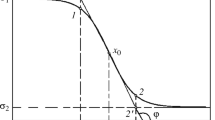Conclusions
Prolonged tests of ring samples at 750°C shows that the relaxation of stress decreases continuously during testing for 20,000 h. Apparently, this decrease is due to the gradual stabilization of the structure of the alloy investigated.
Similar content being viewed by others
Literature cited
I. A. Oding, Reports of the Central Scientific Research Institute of Machine Construction, Book 23 [in Russian], Moscow, Mashgiz (1949).
Ya. S. Gintsburg, Stress Relaxation in Metals [in Russian], Moscow, Mashgiz (1957).
A. M. Borzdyka, MiTOM, No. 1 (1964).
A. M. Borzdyka, Zavodskaya laboratoriya, No. 11 (1963).
Additional information
Central Scientific Research Institute of Ferrous Metallurgy Translated from Metallovedenie i Termicheskaya Obrabotka Metallov, No. 7, pp. 39–42, July, 1965
Rights and permissions
About this article
Cite this article
Borzdyka, A.M. Prolonged resistance to relaxation of refractory Ni−Cr alloys. Met Sci Heat Treat 7, 462–465 (1966). https://doi.org/10.1007/BF00650730
Issue Date:
DOI: https://doi.org/10.1007/BF00650730



